Fingerprint Identification and Classification Principles
1/106
There's no tags or description
Looks like no tags are added yet.
Name | Mastery | Learn | Test | Matching | Spaced |
|---|
No study sessions yet.
107 Terms
Fingerprinting
Method of identifying individuals using unique patterns.
Alphonse Bertillon
Introduced systematic personal identification in 1883.
Anthropometry
Measurement system for identifying individuals based on body dimensions.
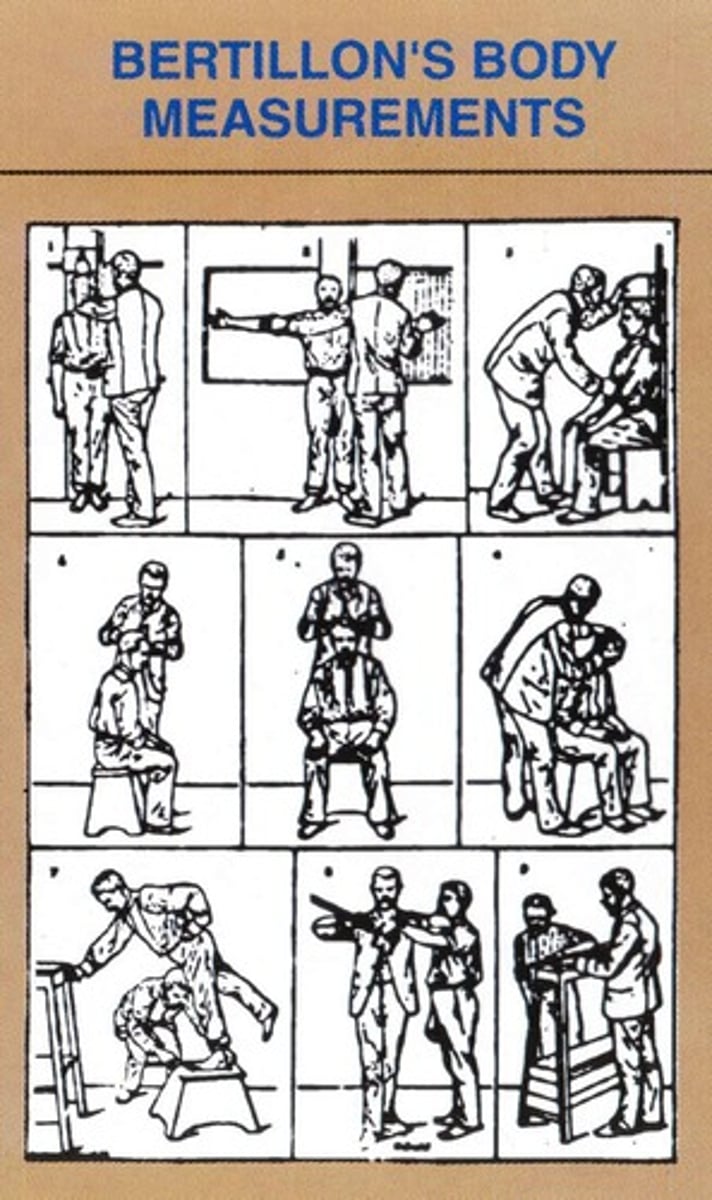
Portrait Parle
Combination of photographs and measurements for identification.
Bertillon System
Identification method using detailed physical descriptions and measurements.
Identification Probability
4,191,304 to 1 chance of identical measurements.
First Criminal Identification
Bertillon's first identification occurred in 1883.
Chinese Fingerprints
Used for signing legal documents 3000 years ago.
William Herschel
Required fingerprints for contracts in India.
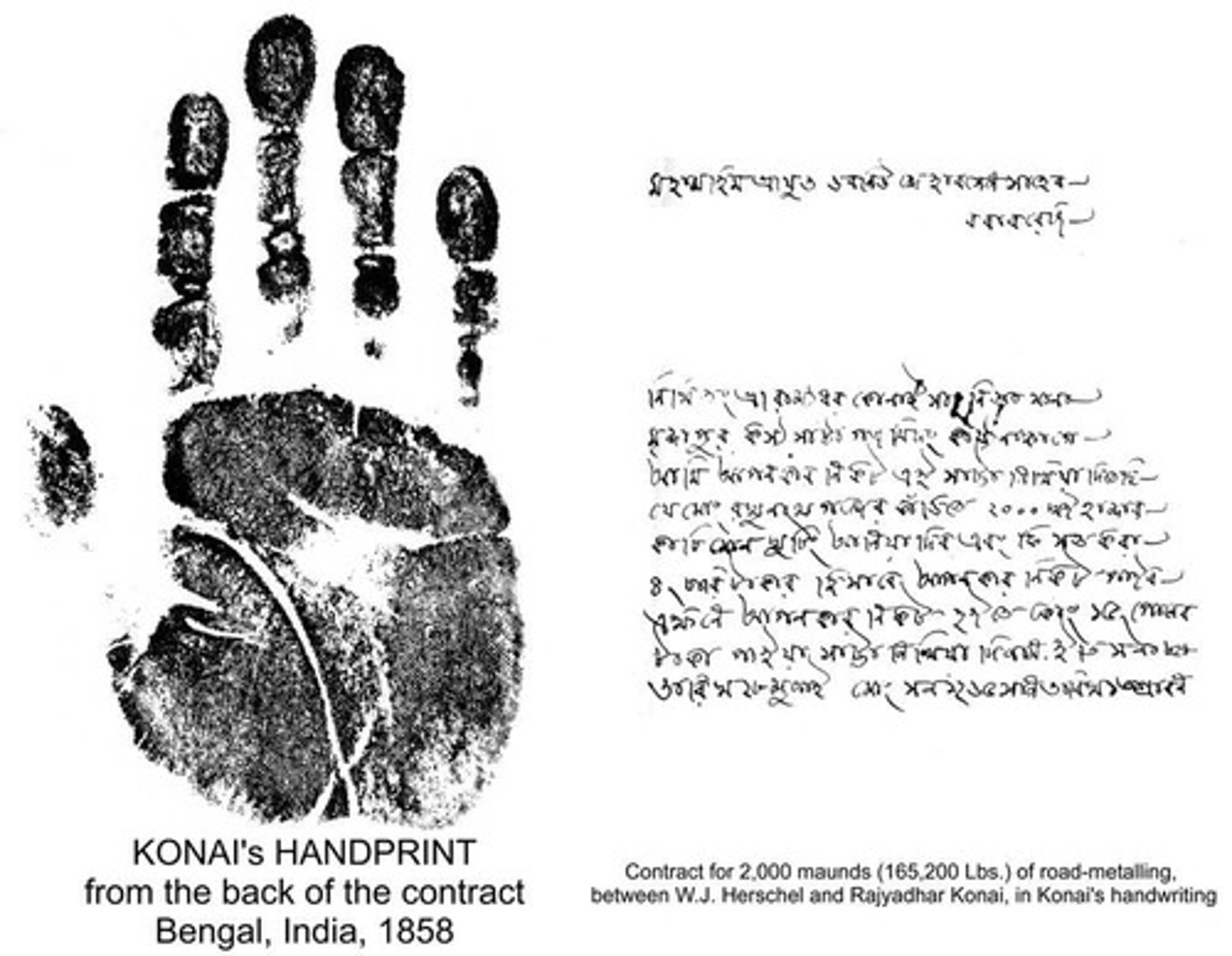
Henry Fauld
Proposed fingerprints as infallible identification proof.
Fingerprint Bureau
Fauld's proposal to Scotland Yard for fingerprint testing.
Francis Galton
Classified fingerprints into loops, arches, and whorls.
Fingerprint Anatomy
Study of fingerprint structure and recording methods.
Unique Fingerprints
No two fingerprints are identical; remain unchanged over time.
Vucetich System
First workable fingerprint classification system created in 1891.
Henry Classification System
Adopted by Scotland Yard for fingerprint classification in 1897.
Visible Fingerprints
Prints that are easily seen with the naked eye.
Plastic Fingerprints
Impressions left in soft materials like wax or clay.
Latent Fingerprints
Invisible prints left by perspiration and oils requiring development techniques to be seen.
Automated Fingerprint Identification System (AFIS)
Computerized system for storing and comparing fingerprints.
Fingerprint Preservation
Proper methods to maintain developed latent fingerprints.
Fingerprint Analysis Tools
Instruments used to enhance and analyze fingerprint details.
Will West Incident
fingerprinting began to be used in earnest in all major cities of the U.S.
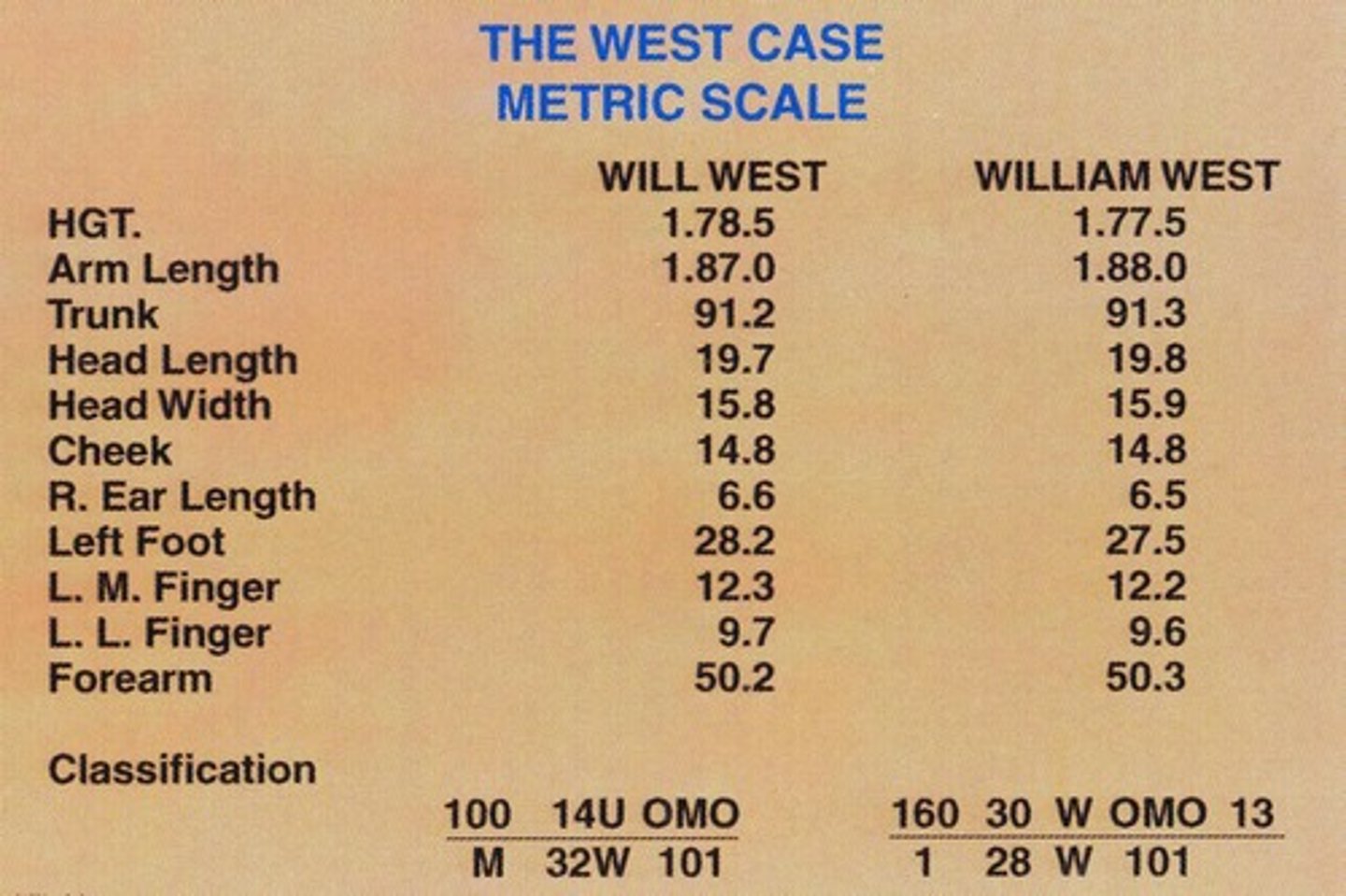
Fingerprinting Adoption
Systematic use of fingerprints began in 1901.
Friction Ridges
Unique skin patterns on fingers for identification. Tiny raised lines on digits, palms, and soles.
Galton's Statistic
Probability of identical fingerprints is 1 in 64 billion.
Ridge Characteristics
Minutiae that define fingerprint individuality.
FBI Database
Largest fingerprint collection globally, nearly 50 million.
U.S. v. Byron C. Mitchell
1999 case challenging fingerprint evidence admissibility.
Unique and Permanent
Human friction ridges are distinct throughout life.
Partial Impressions
Most crime scene prints are incomplete samples.
Ridge Comparison Criteria
8-16 minutiae suggested for fingerprint matching.
Identification Records
Merged fingerprint records formed the FBI's nucleus.
Fingerprint Evidence
Judge upheld fingerprints as valid scientific evidence.
Individual Characteristic
No two fingerprints possess identical ridge characteristics.
Fingerprint Patterns
General shapes do not determine fingerprint individuality.
Relative Location
Matching prints must have identical minutiae positions.
Minutiae
Specific ridge characteristics that establish fingerprint identity.
Friction Ridge Skin
Skin patterns on fingers used for identification.
Major Cities Usage
Fingerprinting became common in U.S. cities post-1904.
Admissibility Ruling
Court confirmed fingerprints as reliable forensic evidence.
Identification Training
Police trained in fingerprinting at 1904 World's Fair.
FBI Fingerprint Collection
Largest collection, crucial for criminal identification.
Lifetime Changes
Fingerprints remain unchanged throughout a person's life.

Friction Skin
Skin type providing grip and slippage resistance.
Epidermis
Outer layer of skin composed of cells.
Dermis
Inner layer of skin beneath the epidermis.
Dermal Papillae
Boundary cells between epidermis and dermis.
Skin Ridge
Raised lines forming unique fingerprint patterns.

Pores
Openings for sweat gland ducts on skin.
Fingerprint
Impression of friction ridges on fingers or thumbs.
Imprint
2-dimensional representation of a fingerprint.
Indentation
3-dimensional representation of a fingerprint.
Permanent Scar
Scar formed from deep skin injury affecting identification.
Core
Approximate center of a fingerprint pattern.
Delta
Point of divergence in fingerprint ridge patterns.
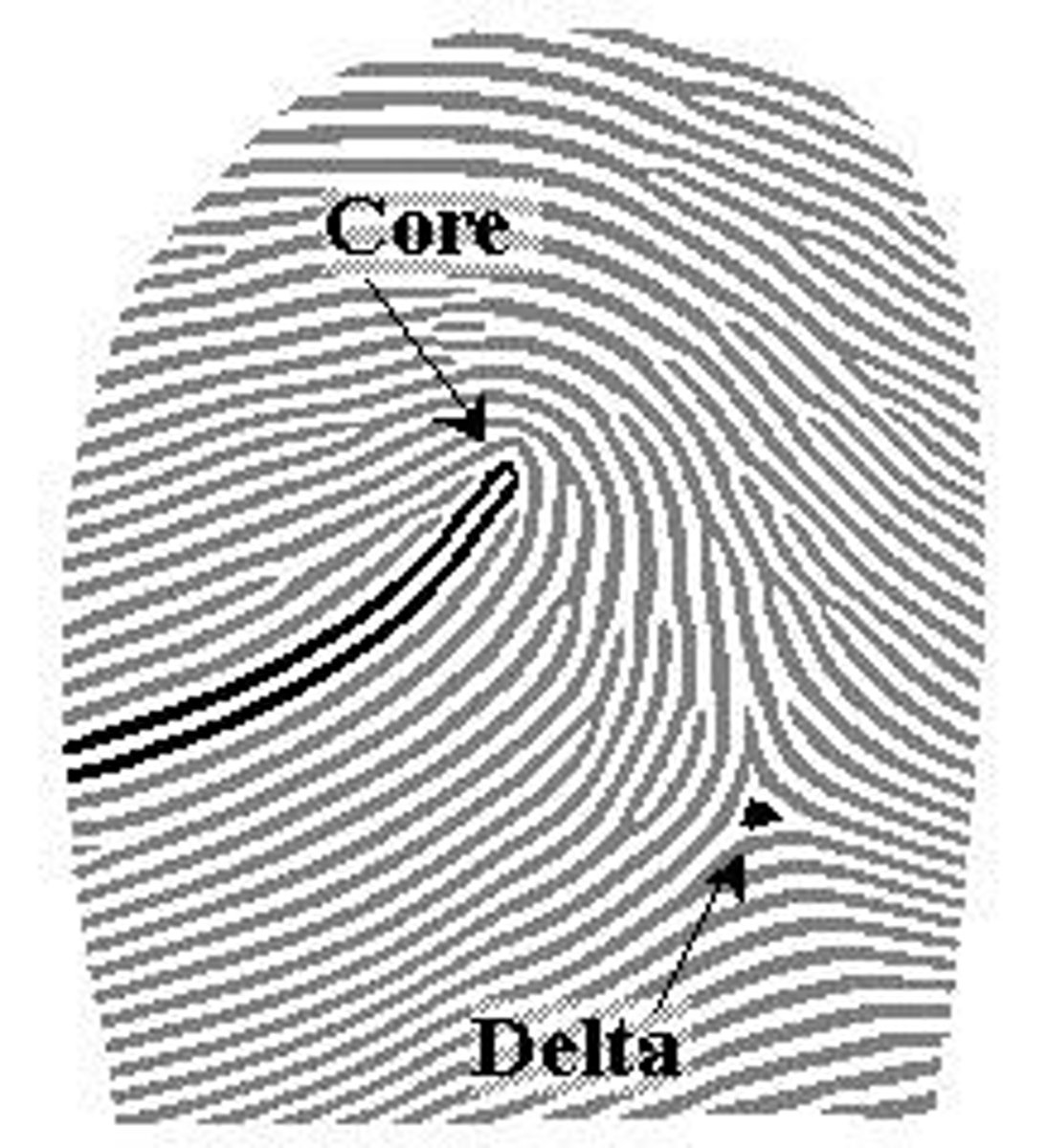
Loop
Pattern where ridges enter and exit same side.
Ulnar Loop
Loop pattern opening towards the little finger.
Arch
Fingerprint pattern with ridges that rise in the center.
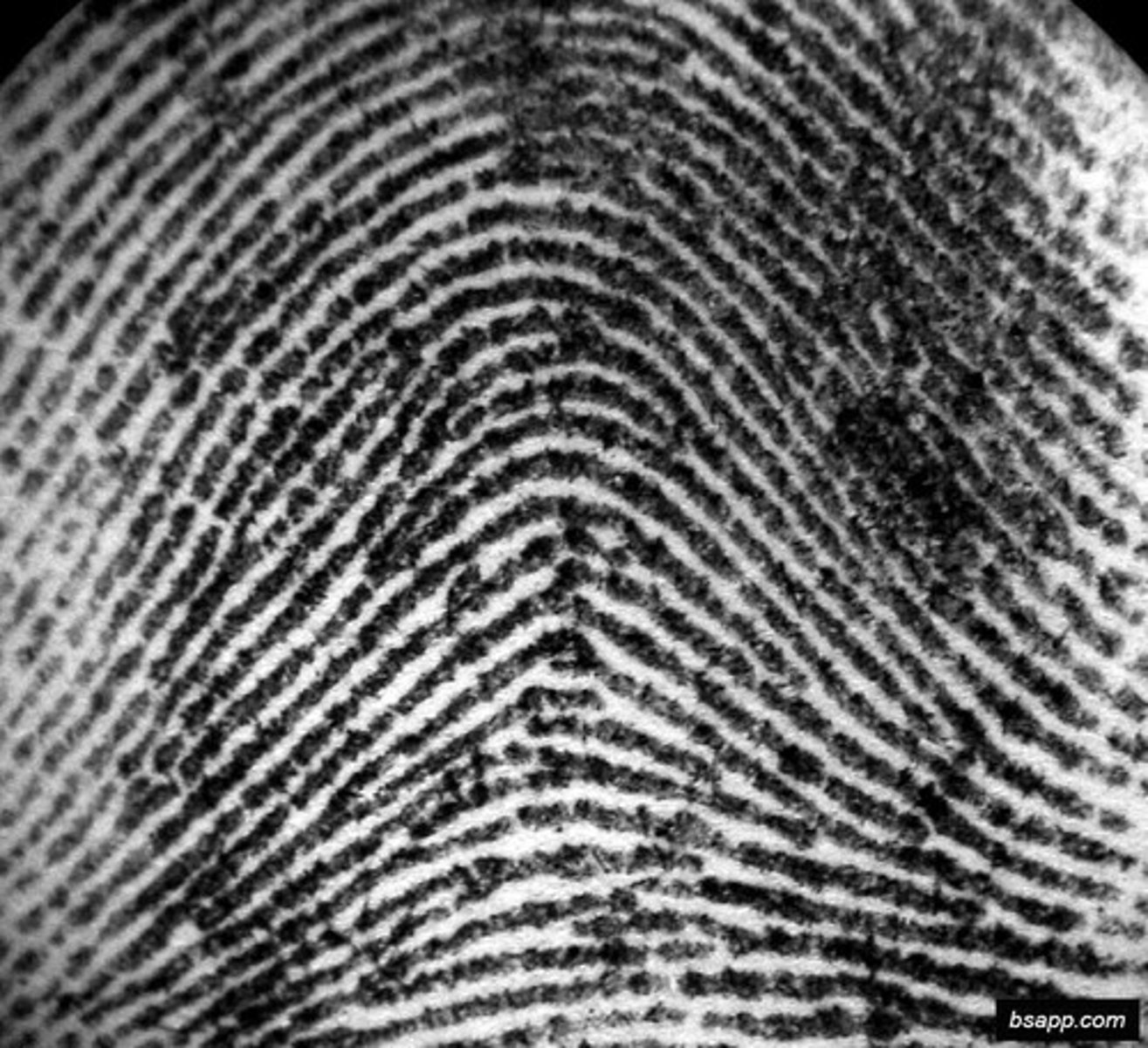
Whorl
Fingerprint pattern with circular ridges around a core.
General Ridge Patterns
Classification system for identifying fingerprint types.
Cancer Drug Effects
Capecitabine causes fingerprint eradication in patients.
John Dillinger
Criminal who attempted to destroy his fingerprints.
Fingerprint Classification
Systematic categorization based on ridge patterns.
Radial Loop
Loop pattern opening toward the thumb.
Arch Pattern
Ridges flow in one side, exit opposite.
Plain Arch
Ridges enter one side, rise, exit opposite.
Tented Arch
Arch with angle or upthrust characteristics.
Whorl Patterns
Fingerprint patterns with two deltas and a recurve.
Plain Whorl
Complete circuit with two deltas and a recurve.
Central Pocket Whorl
One recurve, two deltas, no recurve cut.
Double Loop Whorl
Two separate loops, distinct sets of shoulders.
Accidental Whorl
Combination of different patterns with multiple deltas.
Patent Prints
Visible prints from substances like blood or ink.
Plastic Prints
3D impressions in soft materials like putty.
Latent Prints
Invisible prints from perspiration or oils.
Physical Methods
Fingerprint detection without chemicals or reactions.
Powder Dusting
Main method for detecting latent fingerprints. Powder particles adhere to latent residue.
Standard Fingerprint Powder
Common black or gray powder for prints.
Metallic Powder
Also known as magnetic or magna powder.
Fluorescent Powder
Special powders like red-** or green-**.
Fingerprint Brushes
Tools used for applying fingerprint powders.
Black Powder Brush
Brush for applying standard fingerprint powder.
Magna Brush
Brush used for applying magnetic fingerprint powder.
Fingerprint Detection
Process of identifying fingerprints at crime scenes.
Evidentiary Prints
Prints collected for legal evidence in investigations.
Fingerprint Powder
Two main types: black and gray.
Black Powder
Used on dark surfaces for fingerprinting.
Gray Powder
Used on light surfaces for fingerprinting.
Magna-Powder
Magnetic powder for vertical surface applications.
Metal Filings
Combined with standard powder for gentler application.
Forensic Light Source
Required for viewing fluorescent powder results.
Cyanoacrylate
Superglue method for developing latent fingerprints.
Superglue Fumes
Requires heat, humidity, and enclosed space.
Superglue Print Appearance
Produces white-gray outline on processed objects.
Chemical Methods
Use chemicals for residue reactions on surfaces.
Iodine Fuming
Physical technique for porous surfaces using iodine.
Ninhydrin
Reacts with amino acids, stains prints purple.
Application of Ninhydrin
Spray mist, incubate for optimal results.
Health and Safety
Use gloves, ventilation, and clean equipment.